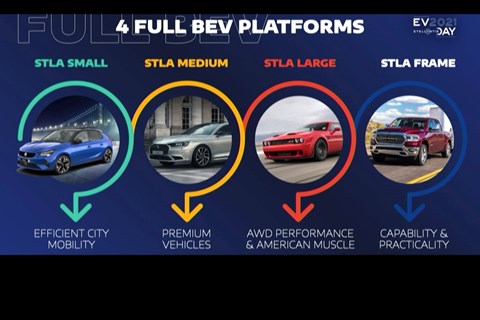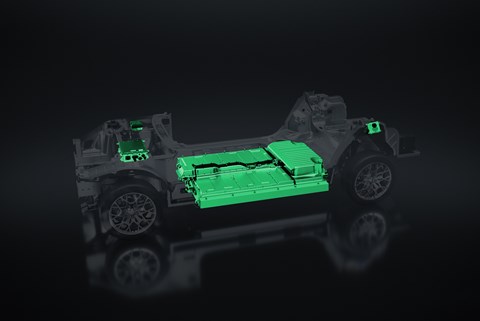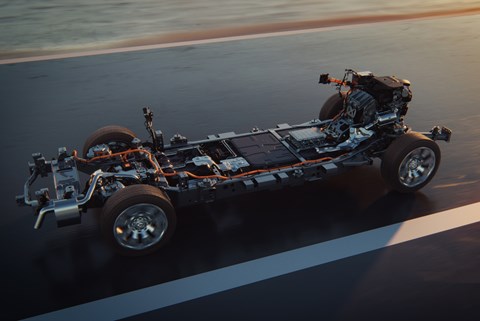► CAR’s debrief on Stellantis’ STLA platforms
► Small, Medium, Large and Frame versions
► Frame the latest in focus; Small due in 2026
Automotive mega-group Stellantis is in the process of rolling out its wave of new ‘EV native’ STLA platforms across all of its major brands. The four STLA platforms (Small, Medium, Large and Frame) are designed to unify all its brands under a set of architectures based on size.
All of the STLA platforms are designed to run not just battery-electric powertrains but ones that use hybridised combustion engines, too. Stellantis is playing the powertrain field even wider with its larger platforms. ‘This, from a flexibility standpoint, is a very significant strength,’ says Carlos Tavares, Stellantis CEO. ‘We have to manage the uncertainty and manage the transition. We offer the consumer the power of choice on the basis of these four STLA platforms – they are all multi energy.’

Medium is rolling out, with models like the Peugeot 3008 and 5008, as well as the new Vauxhall Grandland also using the architecture. The next to hit dealers will be cars based on Large, which includes the new Jeep Wagoneer S that will launch in Europe in the middle of 2025.
Next to get the focus of attention is STLA Frame – arguably the most self-explanatory. It’s a body-on-frame platform designed for the biggest and toughest vehicles in Stellantis’ portfolio. In 2025, we’ll likely start to see more regarding STLA Small as the project comes to development fruition.
We’ve got all you need to know on all four of Stellantis’ new platforms, so keep reading.
STLA Small: the city and small car architecture
STLA Small will benefit all brands that have city cars and superminis in their portfolios. This platform allows for battery capacities between 37 and 82kWh, with a range target of 300 miles. New EVs expected to use this platform include the next generation of small cars from the likes of Opel/Vauxhall, Peugeot, Fiat and Citroen. ‘With STLA Small, we’re talking about compact cars,’ says Tavares in a press conference on 19 November 2024; ‘that will come late 2025, maybe early 2026 – that is the appropriate time for its presentation.’
STLA Medium: filling in the middle ground
Medium was the first of the new STLA architectures to come on stream. Battery ranges were originally planned to be between 87 and 104kWh when first announced in 2021, but the aforementioned Peugeot uses a smaller 74kWh pack. Medium also allows for mild hybrid combustion engine variants, as well as EVs that can claim more than 400 miles on a charge.
STLA Large: for premium and performance cars
Stellantis says Large will be used for upcoming ‘D and E-segment’ cars by Alfa Romeo, Chrysler, Dodge, Jeep and Maserati – and the first cars to deploy the platform are the Jeep’s Wagoneer S SUV and Dodge Charger Daytona. In fact, eight car launches using STLA Large will happen between now and 2026, including replacements for the Alfa Romeo Giulia and Stelvio and possibly a new DS model.

STLA Large is designed to be ultra-flexible, offering both 400- and 800-volt architectures, and has been designed to cater to high-performance cars as well as properly capable off-roaders. Front-, rear- and all-wheel drive configurations are possible using Stellantis’ own ‘EDM’ electric motors.
As for power and performance, this is where Stellantis seems to be hitting a home run. Battery sizes of between 85 and 118kWh are possible, with up to 500 miles of range claimed for the sleekest and lowest saloons that will use STLA Large (like the upcoming replacement for the Alfa Romeo Giulia expected from 2026).
On top of that, Stellantis says cars running on STLA Large could sprint to 62mph in as little as two seconds, and points out that the most potent cars running on STLA Large ‘will outperform any of the existing Hellcat V8s.’ Having an 800-volt architecture as an option also allows cars running STLA Large to collect 4.5kWh of battery charge per minute.
STLA Frame: for heavy-duty trucks and 4x4s
The newest in focus, and a self-explanatory body-on-frame chassis. Stellantis says that this is only for use by Ram and Jeep, and has been entirely developed in the US given Stellantis North America’s experience with this type of architecture.

Frame is quite possibly the most flexible of all the STLA platforms, as Stellantis says it can run combustion, hybrid and battery-electric powertrains as well as range extenders and even hydrogen fuel cell configurations. Naturally, this platform will be what Ram’s future generation of trucks runs on, as well as the next-generation Wrangler.
Choose a Frame BEV and you’d benefit from a truck or 4×4 that’s capable of up to 500 miles on a charge, and can use either a 400 or 800-volt electrical architecture. But Stellantis is also launching a range extender (which it labels as a REEV) that can reach 690 miles of total range.
Naturally, given this is a platform for trucks, Stellantis is also keen to point out STLA Frame’s 6350kg towing capacity, as well as its 1224kg payload capacity.
What will power STLA cars?
As for the powertrains, Stellantis announced in 2021 that it will use three separate electronic drive modules. EDM 1 will be 400V and put out 70kW (93bhp) per unit, making it light and handy for small city cars that don’t require much power, or around 186bhp if applied to each axle for electric all-wheel drive. EDM 2, too, is 400V and can range in power from 125kW to 180kW (164bhp to 241bhp). EDM 3 can work with either a 400V or 800V electronic architecture, delivering between 150kW and 330kW (201bhp to 443bhp).